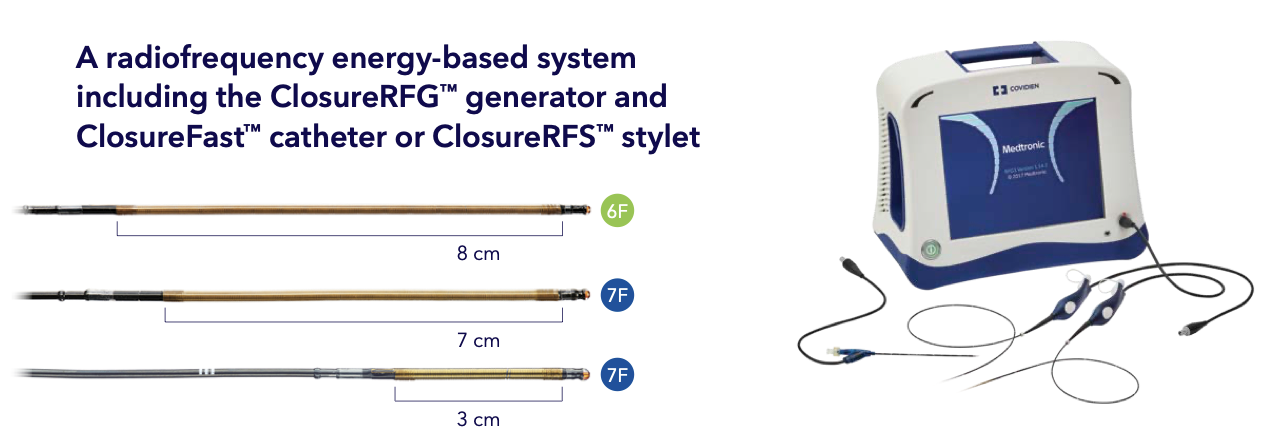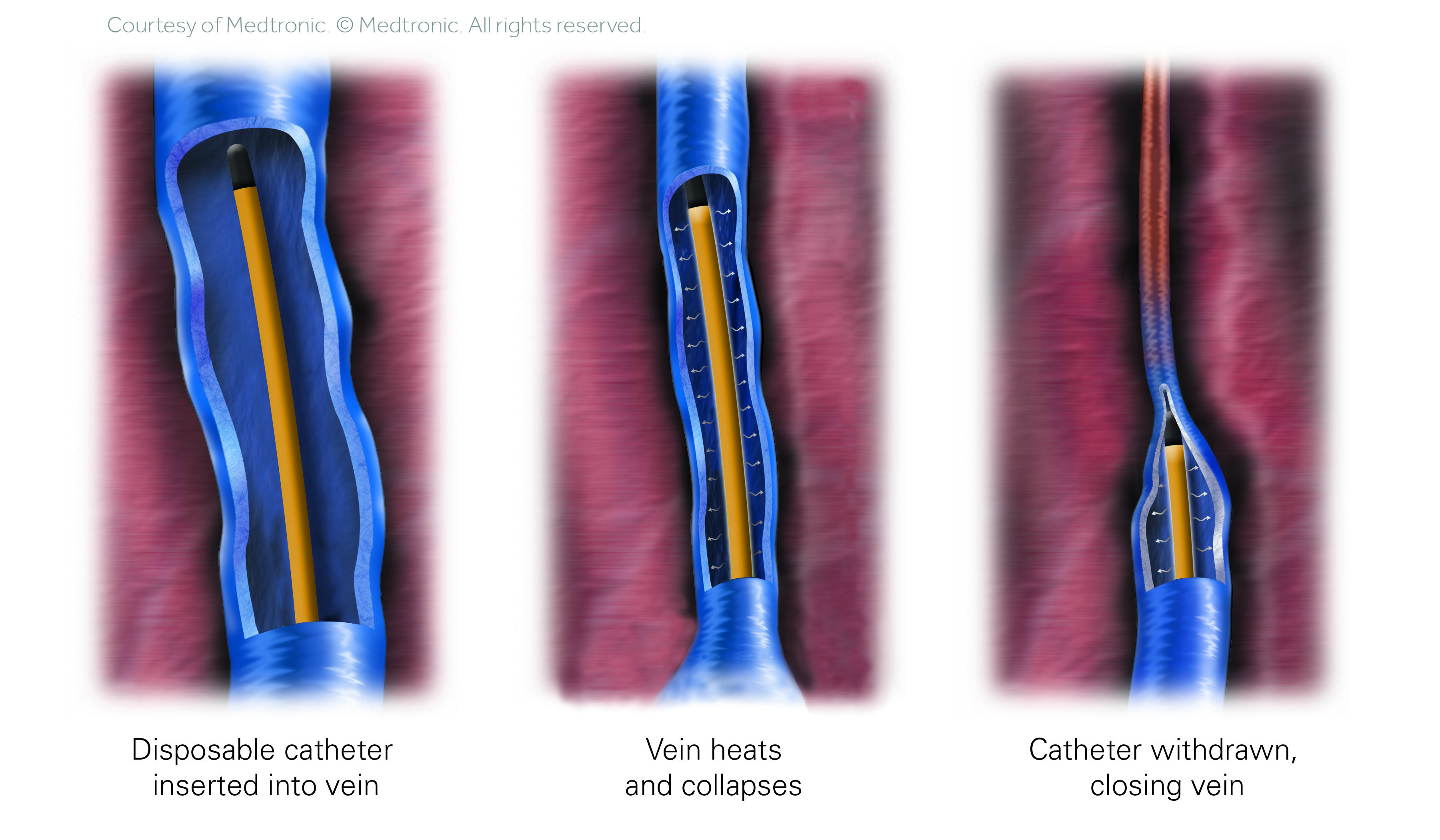ClosureFast™ Radiofrequency Ablation System

Radiofrequency ablation is a simple and gentle procedure where a thin, soft tube (called a catheter) is placed into the problem vein through a tiny opening in the skin. This tube sends out radiofrequency energy, which warms up the vein just enough to safely close it. Once the vein is closed, the tube is removed, and your body begins to heal right away. Over time, the closed vein is naturally absorbed, and your blood flow is smoothly redirected through nearby healthy veins.
Learn More About Radiofrequency Ablation
How It Works
Radiofrequency ablation uses heat to close problem veins, redirecting blood flow to healthier veins. This minimally invasive procedure ensures quick recovery and effective results.
- Relief of symptoms after two days, with a noticeable improvement in one to two weeks.
- Tiny Entry Point: A small opening is made in the skin, usually near the affected vein.
- Inserting the Catheter: A very thin, flexible tube (called a catheter) is gently guided into the vein.
- Targeting the Problem Vein: The catheter is carefully positioned along the damaged or varicose vein.
- Applying Gentle Heat: The catheter sends out radiofrequency energy, which heats the vein walls.
- Sealing the Vein: The heat causes the vein to collapse and seal shut.
- Catheter Removal: The catheter is then removed, leaving no stitches needed.
- Natural Healing: The closed vein is gradually absorbed by your body over time.
- Blood Flow is Rerouted: Your blood naturally finds its way through nearby healthy veins, improving circulation.
Benefits
Experience reduced pain, improved circulation, and a quick return to daily activities. RFA is a safe and effective treatment for varicose veins with minimal downtime.
- ✅ Minimally Invasive: RFA uses a tiny catheter and a small skin puncture—no large incisions or stitches.
- 🕒 Quick Recovery Time: Most patients return to normal activities within a day or two.
- 💡 Effective Results: RFA is highly successful in closing problematic veins and relieving symptoms like pain, swelling, and heaviness.
- 🧼 Less Pain & Bruising: Compared to traditional vein surgery, RFA typically causes less discomfort and fewer side effects.
- ⏱️ Fast Procedure: The treatment usually takes less than an hour and is done in-office or outpatient settings.
- 🚫 No General Anesthesia Needed: Local anesthesia is used, reducing risks and allowing a quicker recovery.
- 🦵 Improved Leg Appearance & Comfort: Helps reduce visible varicose veins and improves overall leg health and comfort.
- 🩺 Long-Term Relief: Many patients experience long-lasting symptom relief and improved quality of life.
What to Expect
The procedure is performed in a comfortable outpatient setting. Most patients report little to no discomfort and can resume normal activities within a day.
- ✅ Before the Procedure
- Initial Consultation: Your provider will assess your vein health and may perform an ultrasound to map out the problem veins.
- Pre-Procedure Instructions: You may be asked to avoid certain medications, wear loose-fitting clothing, and drink plenty of water.
- No General Anesthesia: Only local anesthesia is used—so you’ll be awake, relaxed, and comfortable during the procedure.
- 🩺 During the Procedure
- Quick & Comfortable: The procedure typically takes 30–45 minutes.
- Minimal Discomfort: You may feel slight pressure or warmth, but the local anesthesia keeps you comfortable.
- Tiny Incision: A thin catheter is gently inserted into the vein through a small puncture in the skin—no stitches required.
- 💙 After the Procedure
- Immediate Walking Encouraged: You will be asked to walk right after—it helps with circulation and healing.
- Compression Stockings: You may be advised to wear them for a few days to aid healing and reduce swelling.
- Minimal Downtime: Most patients return to work and normal activities the next day.

Procedure:
Your physician will perform the ClosureFast procedure. Using ultrasound, your physician will position a catheter in the diseased vein through a small opening in the skin. The small catheter delivers heat to the vein wall, causing it to shrink and seal the vein. Once the diseased vein is closed, blood will reroute itself to other healthy veins. Following the procedure, your physician will apply a simple bandage over the insertion site, and may give you compression stockings to aid the healing process. Your physician may encourage you to walk, and to refrain from extended standing and strenuous activities for a period of time. The average patient typically resumes normal activities in a few days.
ClosureFast™ Endovenous Radiofrequency (RFA) Ablation Catheter
Indications for Use: The ClosureFast™ endovenous radiofrequency ablation (RFA) catheter is intended for endovascular coagulation of blood vessels in patients with superficial vein reflux.
Contraindications: The ClosureFast catheter is contraindicated for use in patients with thrombus in the target vein segment.
Potential Adverse Effects of the Device on Health: The potential complications include, but are not limited to, the following: adjacent nerve injury, hematoma, pulmonary embolism, thrombosis, infection, phlebitis, skin burn or discoloration, and vessel perforation.
Important: Please reference the Instructions For Use (IFU) for a complete listing of indications, contraindications, warnings and precautions, adverse effects, and suggested procedure.
Frequently Asked Questions
Radiofrequency Ablation (RFA) is a minimally invasive procedure used to treat varicose veins caused by chronic venous insufficiency. It uses radiofrequency energy (heat) to close off malfunctioning veins, allowing healthy veins to take over blood flow.
Return quickly to an active lifestyle!
